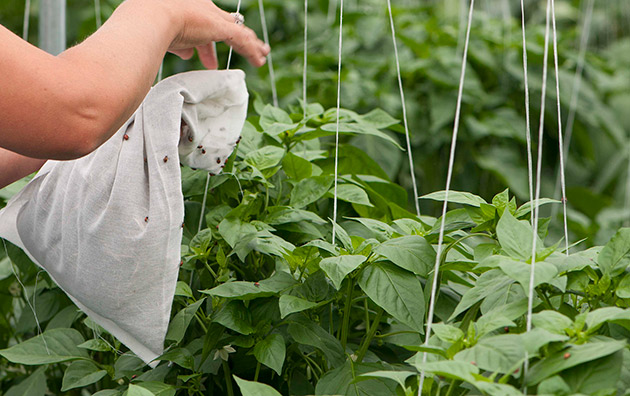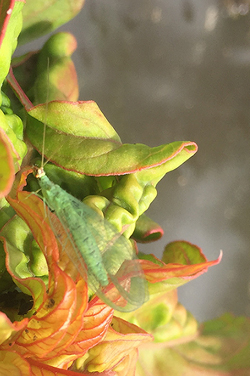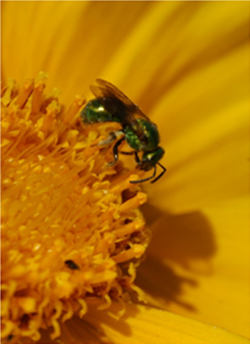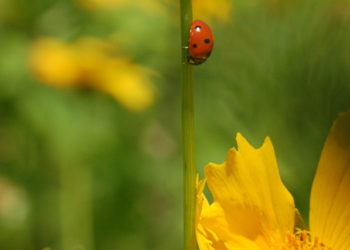With 5 Steps to Establishing a Flowering Insectary
Helping Insects Help You Grow
"…[O]f the world's 94 major crop plants, 18% are pollinated by the wind, 80% by insects (92% of these by bees), and about 2% by birds."
— What Good Are Bugs?
by Gilbert Waldbauer
Mention insects to growers, and many will think of pests and different ways to eliminate them. Many others of us are intrigued by the hyperdiversity of insects — while some devour crops, most are benign, and others are integral to farming success. By turning our flowers into fruit (the pollinators), attacking crop pests (the natural enemies), and providing innumerable other ecosystem services, beneficial insects help make farms more profitable and sustainable.
Of the 1.5 million formally described species on earth, the majority are insects. Yet the precise roles of insects and their significance are still poorly understood by most of us. In this article we look at a few examples that work to the benefit to growers. Next, we outline 5 steps for establishing an insectary — a flowering "set-aside" or "bee pasture" — to help support our mutualistic relationships longer-term. For the curious, we offer a list of further reading . By learning how to attract and sustain populations of beneficial insects, your work as a grower can become more rewarding.
Natural Enemies: "Hey... it's a living"
Parasitoid wasp vs. tobacco and tomato hornworms
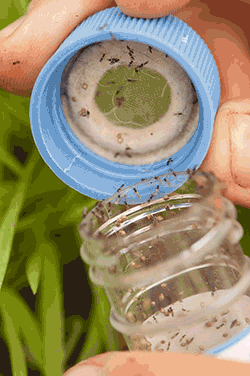
Creating an Insect Hotel
Parasitoid wasps, ladybeetles, lacewings, and other beneficial insects can help control pest populations. Johnny's Greenhouse Manager, Pamela Morin explains how she creates an insect hotel:
"I purchase beneficial wasps for the greenhouses. The wasps lay eggs into the aphids that are eating the crops as well as spreading a harmful virus. This kills the aphids, new wasps hatch out of the aphid bodies, and I get more beneficial wasps for free.
"I also use a banker plant system to sustain the wasps. In short, this involves growing aphids of a species that do not eat peppers or tomatoes, on grass (barley), planted in pots that can be set within the greenhouse. When I release the beneficial wasps, if there are no aphids on the peppers for them to parasitize, they will find the banker plant hosting the aphids that I am growing, and parasitize those aphids. So the wasps stay happy and stick around. It is like creating a perfect wasp hotel!
"But you can only use this system successfully in a setting where there are no other monocot plants growing, because any other monocot plants would be attacked by the type of aphids I grow on the barley grass."
The parasitoid braconid wasp, Cotesia congregates, injects its eggs into the living body of both tobacco and tomato hornworms. The eggs hatch, and the wasp larvae consume the bodily fluids of the hornworm, eventually emerging through the pest, pupating, and leaving the caterpillar to its death.
Parasitoid wasp vs. common asparagus beetle
Anyone who grows asparagus is familiar with the common asparagus beetle. The grayish larvae, covered in their own excrement (the technical term for which is frass) munch on ferns, rendering spears unmarketable and decreasing the plants' ability to photosynthesize and store energy. Like a band of warriors, parasitoid wasps can kill the majority of common asparagus beetles by parasitizing their eggs — in some cases up to 71% of them! This beneficial wasp not only lays its eggs inside of the pests' eggs, it also consumes eggs as an adult.
Hover flies, lady beetles & banker plants vs. aphids
The unchecked growth of aphid populations quickly reduces the marketability of crops. This sap-sucking pest can even transmit plant diseases. Healthy populations of beneficial insects help farmers keep these pests in check.
Lady beetle larvae, for example, consume 100–400 aphids during their development (around 23 aphids per day). As adults they continue to consume aphids at a lesser rate, and moderate population explosions by laying eggs in areas where aphid populations are increasing.
A host of other natural enemies play major roles in aphid control, including lacewings, ground beetles, and hover flies to name a few. The predatory larvae of brightly colored hover flies (also known as flower flies or syrphids), consume legions of aphids to fuel their growth into winged, nectar-feeding adults.
Another method of aphid control is to establish populations of certain aphid species that do not feed on the particular crops you're trying to protect, yet still provide food for natural enemies. Here at Johnny's Selected Seeds, we use banker plants to support these non-pest aphids, thereby maintaining healthy populations of aphid predators in the greenhouse.
Live releases of lady beetles, lacewings, and parasitoid wasps — all supported by flower plantings and strategic placement of banker plants — are essential components of the integrated pest management approach taken here at Johnny's Selected Seeds.
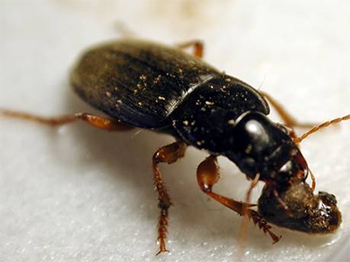
Ground beetles vs. weeds & pests
Ground beetles are another under-heralded farm worker. These cosmopolitan beetles in the family Carabidae consume weed seeds, in some cases decreasing weed pressure in the following year by 80–90%! Farmers can actively encourage the beetles' consumption of weed seeds by making appropriate management decisions. For example, recently shed weed seeds can be allowed to sit on the soil surface, where they are most vulnerable to predation, instead of tilling them in. Ground beetles are also opportunistic predators of many pests, including aphids, cutworms, armyworms, and cucumber beetles, among others.
The Pollinators
"…A surprising spectrum of native invertebrates pollinates crop plants: midges, blowflies, soldier flies, syrphid flower flies, hawk-moths, nitidulid beetles, checkered beetles, ladybird beetles, fig wasps, sphecid and vespid wasps, sweat bees, squash and gourd bees, carpenter bees, andrenid bees, bumblebees, mason bees, leafcutter bees, cactus-loving bees…."
— The Forgotten Pollinators
by Stephen L Buchmann & Gary Paul Nabhan (2012)
Fat and fuzzy bumblebee queens can be seen early in the spring, looking for prime nesting sites to start a colony. Each queen's worker bees will visit flowers throughout the season, turning blueberry, raspberry, apple blossoms, and more into tasty, high-value fruit.
Crop pollination is often one of the major input costs of pollinator-dependant growers. Some farmers annually rent or purchase managed pollinators for crop pollination. Commercially available pollination options include honeybee hives, cardboard boxes of bumblebees, and small tubes of solitary orchard and alfalfa leafcutter bees. Pollinator-dependant greenhouse, high tunnel, and hoophouse growers commonly purchase commercial bumblebee colonies to enhance both the size and number of fruit produced.
Wild, unmanaged bees and other pollinators have been doing this work unbidden for millennia. In fact, in most crops throughout the world, wild bees contribute more to pollination than honeybees, providing a necessary, but free service to growers.
These are but a small fraction of the beneficial insects hard at work, managing pests, protecting the integrity of our crops, and turning flowers into marketable fruit, in fields, gardens, hoophouses, and greenhouses.
Attracting & Enhancing Beneficial Insect Populations
In recent years, many native lady beetle species populations have been displaced through the introduction of exotic ladybug species. For assistance in distinguishing native from exotic types, contact your local cooperative extension agent. In Ohio, where the lady beetle reigns as state insect, the University Extension has produced an identification guide with images and key features.
With modern production techniques and an ever-improving understanding of the life cycles of beneficial insects, innovative growers can adopt strategies to help them work for the bottom line instead of against it.
One such strategy is to install permanent or semipermanent set-asides of flowering plants for pollinators, sometimes called "insectaries."
The best flower mixtures for this purpose contain both annual and perennial wildflowers that provide pollen, nectar, and habitat for beneficial insects year-round. Once established, they fill the entire season with bloom, so that at any given part of their active phase, beneficial insects can frequent two or three simultaneously blooming flowers. Some insectaries additionally enhance the habitat that supports the beneficial insects' quiescent phase.
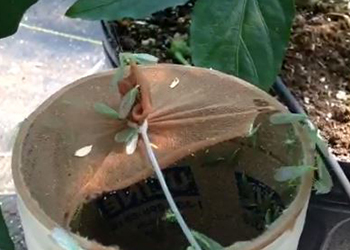
This timing of bloom is essential. Some beneficial insects, like bumblebees, actively forage for pollen and nectar from the early spring to well after the first frost. Unlike honeybees, bumblebees have a very limited ability to store food, and thus require a season-long supply if growers wish to maintain healthy populations to pollinate crops.
Hover flies, parasitoid wasps, lacewings, predatory wasps, and a large number of other beneficials all require nectar as adults. Research has shown that flower-rich plantings not only attract these beneficial insects to your farm, but can actually increase their local populations, help to manage pest populations, and increase crop yields through improved crop pollination and pest control.
Johnny's Beneficial Insect Flowering Mixes
To help growers to take advantage of beneficial insects, Johnny's offers a selection of flower, herb, and farm seed varieties known to Attract Beneficial Insects. Included are several different mixtures of annual and perennial flowering plants that are designed to support natural enemy and pollinator populations.
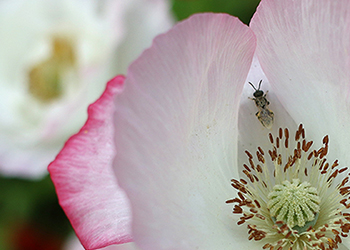
- Beneficial Insect Attractant Mix. This seed mix contains flowers that are especially attractive to both natural enemies, such as sweet alyssum, cilantro, false Queen Anne's lace, fennel, and dill, and those more heavily used by pollinators, such as coreopsis, clover, bergamot and blazing star. This mix offers growers a broad approach to beneficial insect management, providing food for a large swath of both natural enemies and pollinators throughout the season.
- Bee Feed Mix. This seed mix targets pollinators by providing a season-long abundance of a variety of flowers that are especially attractive to bees. This type of flower mixture is especially useful when planted adjacent to crops that rely on, or benefit from pollination. Examples of such crops include orchards, small fruits, berries, tomatoes, squash, pumpkins, cucumbers, and melons.
5 Steps to Establishing a Flower Mix Insectary
Flower mixes are easy to establish, provided the grower follows some general guidelines. The steps outlined below are adapted from a University of Maine Cooperative Extension Fact Sheet coauthored by Eric Venturini, former Education Coordinator here at Johnny's.
1 • Minimize Weed Pressure
The first step to successful establishment of small-seeded flower mixes is the control of weeds, especially weed seeds. A properly prepared seed bed sown to a perennial mixture of flowering plants can continue to provide beneficial insects with forage for 5–10 years only if weed pressure is minimized. In fact, if weeds are not controlled prior to planting, they can and will out-compete the slow-growing perennial flowers within the first year.
Methods that growers can use to drastically reduce the weed seed bank include stale-seed bedding, flame-weeding, soil solarization, topsoil removal, a combination of cover-cropping and stale-seed bedding, or, if necessary, judicious repeat applications of herbicides. Even two or three cycles of stale-seed bedding in the spring prior to sowing a flower mix can greatly reduce weed competition and help to increase the longevity of the planting. See our article on Weed Management Basics to learn more.
2 • Prep the Soil
Flowering mixes require very little fertility input. In wildflower plantings, the addition of fertilizers can actually cause more harm than good, by providing weeds with the materials that they need for growth without benefiting the sown species. We do suggest testing the pH of your soil to determine whether the addition of lime or sulfur is required. A pH that is between 5.5 and 7.0 should be adequate for successful flower establishment. Light shallow tillage to break up the soil structure prior to sowing seed will help increase germination and emergence.
3 • Sow the Seed
Native seed drills, hydro-seeders, and spin seeders like the Ev-n-Spred® are all effective tools for seeding beneficial insect flower mixes. Except in extremely large areas, the Ev-n-Spred Seeder is a practical option that can be easily used to seed plantings of up to several acres.
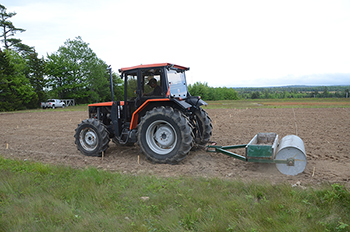
Due to the extremely small size of many of the wildflower seeds within these mixes, when broadcast-seeding, flower seed should be bulked with sand, vermiculite, or something similar to help ensure that the seed is distributed evenly throughout the planted area. After sowing, lightly rake the area with a landscaping rake.
4 • Ensure Seed-to-Soil Contact
Small-seeded annual and perennial flowers, especially wildflowers, require seed-to-soil contact to successfully germinate and establish. Compaction of the seedbed after sowing is extremely important for success. Culti-packers and lawn rollers are both very effective tools for pressing the seeds into the soil.
5 • Maintain: Irrigate the 1st Year & Mow Once Per Year in Late Fall
Once established, these mixes require very little care. During the first year, however, irrigating the stand with ¼ to 1 inch of water per week can help establish slow-growing perennials. We recommend mowing your flower mix once each year in the late fall, after the last flowers have finished blooming.
Small but Mighty
"Ecosystem services are the direct and indirect contributions of ecosystems to human well-being… They support directly or indirectly our survival and quality of life.…."
Beneficial insects go about their business in countless, complex ways that are integral not just to agriculture but to the entire web of life. Of all the crop plants commonly grown around the world, a large majority are more or less dependent upon insects — both for pollination, competitive pressure against pests, and a wide variety of other ecosystem services. Without them, our lives would be very different, our diets very poor and strange indeed. A resourceful grower is one who provides them safe haven and puts their small but mighty talents to good purpose.
Learn More About Attracting & Supporting Beneficial Insects
- Notes on the Pollinator Issue • Article
- Plants for Insectaries: Some Options & Recommendations • Article
- Farmscaping & Biological Control • Article
- Buckwheat: Quick & Easy Summer Insectary/Smother Crop • Article
- Banker Plants • Blog Post
- Lady Beetles • Blog Post
- Hover Flies • Blog Post
- The Beauty of Pollination • Blog Post
- Seeds for Plants that Attract Beneficial Insects • Product List
References
- Enhancing Wild Bees for Crop Pollination: Sowing Bee Pasture for New England's Wild Lowbush Blueberry • University of ME Cooperative Extension
- Using Farm Bill Programs for Pollinator Conservation • USDA NRCS National Plant Data Ctr
- The Common Asparagus Beetle and Spotted Asparagus Beetle (Coleoptera: Chrysomelidae): Identification, Ecology, and Management • J Integrated Pest Management
- The Multicolored Asian Lady Beetle, Harmonia axyridis : A Review of Its Biology, Uses in Biological Control, and Non-target Impacts • J Insect Science
- Wild Pollinators Enhance Fruit Set of Crops Regardless of Honey Bee Abundance • Science
- Inordinate Fondness Multiplied and Redistributed: The Number of Species on Earth and the New Pie of Life • Quarterly Review of Biology
Plants for Insectaries: Some Options & Recommendations
Farmscaping & Biological Control
Buckwheat: Quick & Easy Summer Insectary/Smother Crop
Banker Plants • Blog Post
Friend of the Week: Lady Beetles • Blog Post
Friend of the Week: Hover Flies • Blog Post
The Beauty of Pollination • Blog Post
Attracts Beneficial Insects • Product List
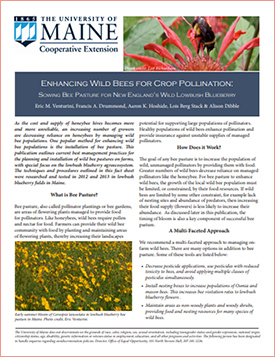
Enhancing Wild Bees for Crop Pollination: Sowing Bee Pasture for New England's Wild Lowbush Blueberry • University of ME Cooperative Extension
Using Farm Bill Programs for Pollinator Conservation • USDA NRCS National Plant Data Ctr
The Common Asparagus Beetle and Spotted Asparagus Beetle (Coleoptera: Chrysomelidae): Identification, Ecology, and Management • J Integrated Pest Management
The Multicolored Asian Lady Beetle, Harmonia axyridis : A Review of Its Biology, Uses in Biological Control, and Non-target Impacts • J Insect Science
Wild Pollinators Enhance Fruit Set of Crops Regardless of Honey Bee Abundance • Science
Inordinate Fondness Multiplied and Redistributed: the Number of Species on Earth and the New Pie of Life • Quarterly Review of Biology


